#Butterfly saga
Text


Yesterday one of my caterpillars was unaccounted for and I checked EVERYWHERE! They’ve been constantly escaping the critter keeper so I’ve put paper towel with the lid to stop them from getting through and just accepted the loss
This morning I found a caterpillar on the outside of the tub, went to count the ones inside, THE MISSING BABY CAME BACK AND WAS TRYING TO GET BACK IN
All wormies are accounted for and safely back in their bin now!
7 notes
·
View notes
Text
More Grey Matters: Episode 75—Taylor-made
If you would like to “Buy Me a Glass of Wine,” you can click this link or the ***DONATE*** link at the bottom of the menu on the left.
Including this one, six more episodes remaining in Season Six.
All previous disclaimers apply.
Episode 75—Taylor-made
JASON
Things moved along pretty much like I expected they would once we got back from Detroit. The trip itself was an enigma to say the least. I…

View On WordPress
#Ana Grey#Ana Steele#Anastasia Grey#Anastasia Rose Steele#Anastasia Steele#Becoming Dr. Grey#Ben Lawrence#Benjamin Lawrence#BG Holmes#Bronze Goddess#Butterfly#butterfly saga#Charles Davenport#Christian Grey#Chuck Davenport#Detroit#Dr. Grey#Dr. Steele#Fiction#Gail Taylor#Grey Continued#Grey Crossing#Jason#Jason Taylor#love and handcuffs#Mending Dr. Steele#Misadventures#More Grey Matters#Paging Dr Steele#Raising Grey
2 notes
·
View notes
Text
Kind of envious our priest’s monarch caterpillar is going into pupae mode tonight and I cannot watch and only wait for updates via text.
I went for a walk this afternoon kind of looking for a monarch caterpillar of my own and lo! I actually came across a man doing the same thing, bent over in a bunch of milkweed. I scared him half to death asking, “Looking for monarchs?” And then we stood by the road talking butterflies for 15 minutes or so. He and his wife have raised and released 80 so far this summer.
Kind of weird to go out looking for caterpillars and find instead the local Butterfly Man but hey I guess that is what life is like now.
#I hadn’t walked down that road since last winter#and lo!#our priest got a second one at the farm stand already in chrysalis#‘as backup’ she said#butterfly saga
2 notes
·
View notes
Text
Tropical Milkweed, Its Problems, and What To Plant Instead
I am writing this to atone for the sins of my past (handing out tropical milkweed cuttings to my friends and teachers before I knew better).
(Also let me make this clear I am Floridian I am writing this from the perspective of someone in the United States if you live in Tropical Milkweed's native range this doesn't apply to you go forth pogchamp)
Look online, on TV, in books, in newspapers, left, right, up, down, anywhere, and you'll see people talking about how planting milkweed is crucial, essential for the survival of monarch butterflies. Milkweed is the only plant that monarch caterpillars can eat as they're growing, and the loss of it in our wild spaces is one of the most direct links to the ecological extinction speedrun of not just monarchs, but dozens of other insects who rely on its abundance of nectar-filled flowers to survive. You'll be urged to run, not walk, to your nearest garden center, buy as much milkweed as you can, and hurry fast to plant it in your gardens and be part of the solution, not the problem. The issue is that, oftentimes, the milkweed you leave the store with is a vibrant red and orange, with pointed green leaves, dozens like it lining the shelves across stores all over the nation...
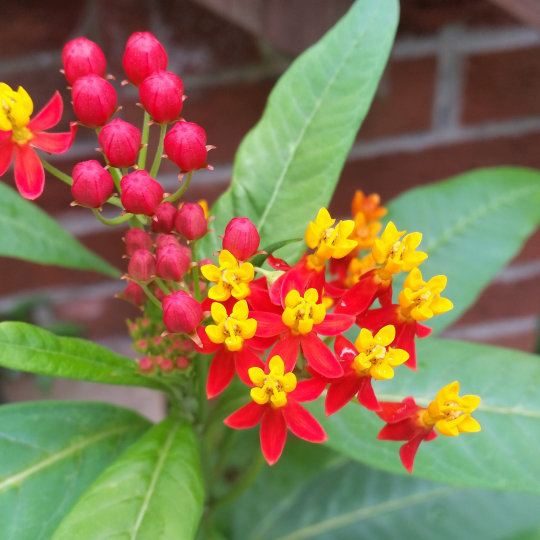
Tropical milkweed. Scarlet milkweed. Bloodflower. Mexican butterfly weed. Asclepias curassavica. This plant is a being of many names, and our culprit of the hour.
'Culprit? Culprit of what?' Culprit of enticing people to buy it under the guise of helping, only to possibly cause more harm than good.
Let's discuss.
Tropical Milkweed (Asclepias curassavica) is a gorgeous milkweed (especially the yellow variety? ooh, that had me in a grip as a teen) that's easy to obtain--too easy. It lines the shelves of stores like Walmart, Lowe's, Home Depot, and even hundreds and dozens of smaller garden stores, and is sold for reasonably cheap because its quick and easy to grow from seed and eagerly roots from cuttings. It's extremely popular with butterflies too--in many scenarios, Tropical Milkweed will be preferred as host plants over other related species like Butterflyweed (Asclepias tuberosa), and its also popular with other species of butterfly, bees, and wasps as a nectar source. It lasts well into winter in some areas of the United States, is quick to regrow when cut back, and doesn't die back for periods of the season like some other milkweeds do. It's eager to reseed, creating capsules with tens of dozens of seeds and scattering across the winds with the help of little silky parachutes much like the ones dandelions are known for.
'Ani, what's the problem with that? This all sounds like its great for monarchs!'
See, here's the kickers. In fact, here's several kickers. Here's an entire mollywhopping of kickers.
OE Infections
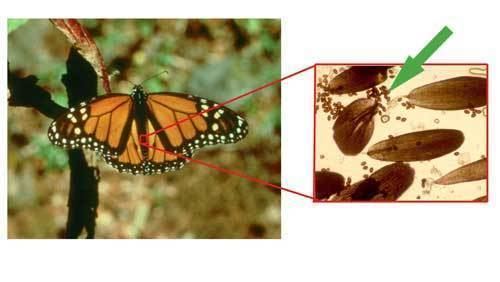
In the temperate areas that it doesn't die back over winter (or even, in some cases, where it doesn't die back during the season like other milkweeds), it can become a host for OE. OE is short for Ophryocystis elektroscirrha, and its a protozoan parasite that can and frequently does infect monarchs. As infected monarchs visit different plants--whether its to drink nectar, to lay eggs, or even just doing a fly-by of the garden--they drop spores from their wings that can then fall onto the leaves, flowers, and even any eggs already on the plant. As caterpillars hatch and begin to eat the plant, they ingest the protozoan, which begins the cycle anew. High OE levels in adult monarchs have been linked to lower migration success, reductions in body mass, lifespan, mating success, and flight ability. And that's if the caterpillars don't succumb prematurely to the infection, or if they're able to even exit their cocoon and fly once they finish pupating--deformed wings are frequently a result after infections. Now, OE is a parasite that's evolved alongside monarchs--and monarchs are usually able to handle an infection just fine, but if they're carrying a high load? That's where the problem lies.

What role does tropical milkweed play in this? Most milkweeds die back after blooming, at least once or even twice per season--and the parasite dies alongside them. As native milkweeds push out fresh foliage, its parasite-free, offering a healthy new buffet for caterpillars. Tropical milkweed... doesn't do that. If nothing's done, (at least in my state of Florida) tropical milkweed will stay fresh and green all the way up until the first real frost hits way in December--and that's if there's a hard frost, when you travel farther south. And during all that time, OE levels are building up on the leaves, so any future caterpillars that feed on this plant are doomed the instant their egg is laid on a leaf.
Its not that it's utterly impossible for a monarch to get infected with OE on any other kind of milkweed--monarchs are known for their traveling habits, and the chances of them happening upon a different milkweed plant than the tropical milkweed in your backyard is pretty high. But whereas native milkweeds die back and essentially reboot their system with fresh, disease-free leaves at least once a season, tropical milkweeds are like downloading a virus onto a USB and then passing it to your friends.
But that's not all, either. Time for kick 2.
Migration Interruption

Sit with me a moment and imagine you're a monarch butterfly. You're hardwired to know that as your food source starts dwindling at home, its time to get a move on and fly on down to the family's vacation home in Mexico for the winter. The buffets shut down, you exit stage left. But on your way to what's essentially a season-long smorgasbord with friends, you find... a buffet is still open. You're supposed to leave when the buffets are shutting down, but this one's up and running, lights are on, and plenty of people are there having fun, so you step in to relax. You'll take your trip later.
Now imagine a bit after you entered that buffet, the staff stuffed the guests into the walk-in freezer, locked the door, turned off all the lights, locked up the building, and left.
That's basically what tropical milkweed being 'evergreen' is doing to monarch butterflies in the fall and winter seasons. In areas up north where it can stay growing far later into the fall/winter months--or worse, in the south, where it can basically be evergreen until a hard frost (if one even happens), it can interrupt the monarchs' iconic migration cycle. They'll stay in place and continue breeding, living life like they aren't supposed to be a country away--until a frost hits, and they're dead in a snap. And if there's not a frost, you're getting a bunch of OE spore-ridden monarchs flying around a bunch of OE spore-ridden milkweed plants that the butterflies who followed the rules and overwintered in Mexico are gonna be returning to. POV you're starting a family in a house so laden with asbestos and black mold that there's practically black dust floating around.
This is already pretty bad. Can it get worse? Absolutely. Kick number 3.
It's Pretty Invasive (in the US)
It's fast growing, its eager to go to seed (so eager that it can flower and produce seed at the same time), its growing all throughout winter--which would be great, if it were native to the United States. Unfortunately, it isn't! As one could imply from the name, Mexican butterfly weed is native to--well--Mexico, as well as the Caribbean, South America, and Central America.
Further North into the states, and it's more of an annual--a plant that lasts maybe a year tops, dies back permanently, and you go buy more next year, or start from seed. Further south? It's a perennial, baby--which means its got even more time to spread its seeds and really thrive in the warmer climates of places like Florida, Texas, California, etc. Not to mention, as climate change makes temperatures rise, places where tropical milkweed is an annual may quickly begin seeing it stand strong all year...
I won't pretend to be a Professional Milkweed Identifier. I'm getting better at it with time, but I'm not a pro. But most of the time I go outside and I go 'oh, that's a milkweed!' its tropical milkweed. I've seen it grow in the sidewalk cracks of a gardening store I go to--its a clean four feet tall, always flowering, always making seeds. Tropical Milkweed is eager to escape the confines of your backyard, or make more plants in your backyard--I started with 5 plants one year, and the next year I had seven, then twelve, and that's just the ones that didn't get mowed over in the seedling stage...
But wait, that's not all! Kick number 4, baby!
Toxic to Monarchs????
According to the Xerces Foundation, emerging research suggests that tropical milkweed may become toxic to monarch caterpillars when exposed to the warmer temperatures associated with climate change.
'What the fuck, I thought milkweed was good for monarchs! How the hell does that happen?!'
All milkweeds produce cardenolides in their sap--a type of steroid that are toxic to most insects (and even people). Milkweeds create it to repel herbivores that would munch on it otherwise--except for milkweed butterflies (Danainae family), like our legendary monarch, as well as the queen and plain tiger butterfly. Larvae eat up milkweed leaves like there's no tomorrow, to stock up on those cardenolides and become toxic to their vertebrate predators--except for a few species that have evolved to become cardenolide-tolerant (black-backed orioles and black-headed grosbeaks). But, when cardenolide concentrations are high enough, it's too strong for even monarch butterflies to withstand--they die because of the very plant that's supposed to give them life. Kinda fucked up. Comparatively, many native species have lower cardenolide levels--and don't immediately go into flux at higher temps like tropical milkweed does.
'Wait, Ani, if there's all these problems with tropical milkweed, why is it sold everywhere?'
Capitalism. The answer is capitalism.
Well, actually, its a bit more complicated than that but it's also still capitalism.

The very same things that make tropical milkweed so invasive and such an issue are what make it so incredibly popular to sell. It's fast growing, and eagerly starts from cuttings as well as from seeds--which is perfect for growing tons of plants in quick and easy batches to send to vendors all over and get a quick profit. It's easy to grow from the home gardener too--its resistant to most diseases, looks gorgeous almost year-round, is quick to return in many areas without even the slightest sign of a die-back, and is popular with monarchs and other pollinators. Want to start a pollinator garden with quick results? Plant milkweed--and when tropical milkweed is all that you see available when you walk into your beloved store, it's what most people are going to get without thinking twice. Not to mention, when you hear it starts quick from cuttings, and you really wanna get your friends and loved ones into pollinator gardening, well... you get well-meaning people sharing invasive plants with their homies, like I did in high school. I've been pollinator gardening for around sixish-sevenish years (I think) and I didn't even catch wind that tropical milkweed was invasive until three years in! To say I was mortified doesn't describe it fully.
'Wait, three years ago? So information about this has been out awhile! Why aren't more places selling native milkweeds by now?! Why are people still buying this invasive milkweed and not native ones?!'
It's capitalism again! But in a different way.
Compared to tropical milkweed, many other milkweeds are a lot more... finnicky to get started, or grow in general. Many of them are a lot slower to germinate, are more prone to failing as seedlings and falling victim to things like 'dampening off' or 'too many aphid' or 'the vibes were wrong.' If they do germinate, they're slower to get to size too--I've grown tropical milkweed from seed in solo cups and gotten something about four inches tall within maybe a month and a half. Some other milkweeds I've grown from seed take about a month and a half to get more than four leaves, or even poke their little green heads out of the dirt. In addition to this, milkweeds have taproots--and some are a lot more friendly to the concept of 'transplanting from a pot to the ground' or 'growing in a pot at all' than others, and tropical milkweed ranks at the top of that list again. Not to mention, their willingness and ability to overwinter in pots--many native milkweeds fail that test, meaning that even if all the resources and efforts are put into getting a milkweed to grow from seed, it won't survive longer than a year in that pot. Considering most milkweeds don't flower until a year or so into their growth, and it's easier to sell plants that are flowering... many plants are a tough sell.
Another reason? Some native milkweeds are way more picky about when they want to make seed pods, or what conditions their seeds want to be grown in. If the seeds are hard to obtain? Good luck growing them in a production greenhouse. Let alone finding seeds for sale to grow them yourself at home--in my hunt for native milkweed species, I've seen packets of ten seeds sold for twenty bucks, packets of 25 seeds sold for anywhere from 50 to 100--meanwhile, you can find dozens if not hundreds of tropical milkweed seeds sold in a pack for maybe a dollar or five.
Let's be real. Producers haven't figured out the magic ticket to pumping out native milkweeds like they have with tropical milkweed--as such, finding native milkweeds for sale is rare, and they're often pricier. And as someone who's been to a native plant sale and found the stands sold out of milkweeds not even 30 minutes into the event--you are likely not the only person wanting native milkweeds. It is war out there in the garden parties.
And that's assuming you've actually found native milkweed for sale! As you get better with milkweed IDs, you'll be able to clearly identify the liars who are telling you they've got something that they don't, but for those who aren't In The Know--if you see a milkweed labeled like a native milkweed and want to buy native milkweed, it might be too late by the time you realize you just got sold tropical milkweed with a mislabel. Whether its on accident or on purpose, it still bites.
I've asked some of my favorite, smaller greenhouses if they'd be willing to start selling native milkweeds. Most of the time I get an exasperated 'I would love to.' But they can only sell what the vendors can produce--so if they can't find a vendor that's selling swamp milkweed (or at least reliably), then they can't give me swamp milkweed when I poke my head in asking if they have any in stock. Of all the times I've gone to dozens of different green houses and gardening events, in different cities even, to see if they have any native milkweeds I've only had success a few times--one small vendor who only has them in stock at events sometimes (and that's if I don't show up late), and the one time I rolled into a not-big-box-but-not-small gardening store near my friends house after being sad that I couldn't find it at a different gardening event. And the one I found there was the last one they had in stock for the next month or two. Until The Vendors get better at growing native milkweeds, your best bet is going to be growing it from seed yourself, getting a start from a friend, or dumb luck at smaller nurseries and events. It's rough out here, friends.
Granted! Keep in mind! That whole last paragraph was personal anecdotes. It's entirely possible that other places' greenhouses have already caught on, and I'm simply in the shadowlands where nobody's selling native milkweeds except for once or twice a year and selling out within 20 minutes of opening their damn booth. And I've heard tell of people getting milkweed popping up willingly in their backyards by doing things as simple as not mowing. I pray you have better luck than I do, young Padawan.
Now, keep in mind, there are people actively working on this. Whether its a team of university scientists dedicating themselves to a project, or a few home-growers in a sunny backyard and a greenhouse doing their damn best to grow native milkweeds as efficiently as possible for themselves and their friends, there are people working on this, sharing advice and communicating online. This isn't some unresolved issue that no one has noticed. We just... aren't at the end post yet. Until then, we scrounge for what we can.
'Oh no, oh god, I have a bunch of tropical milkweed plants in my garden!! Am I a bad person?!?!'
No You Are Not A Bad Person For Growing Tropical Milkweed
And I'm perfectly honest about that. Because I'm here telling you this and I've still got tropical milkweed plants in my backyard. As that one comic once said, about 10,000 people learn something new every day, and unfortunately today that 'new thing' is a bit sad and a bit untimely. In full honesty, oftentimes in my brain I refer to Tropical Milkweed as Starter Milkweed--its what a lot of pollinator gardeners end up starting with, because its just so available! But! There are things that you can do to mitigate the Damage that tropical milkweed can bring to your backyard butterflies.
Step One: Cut back your milkweeds! At least once a year, maybe even twice a year if you want. This will force them to put out new growth, which will be free of OE spores and give monarchs on it a good head start against the Disease. But for sure, for sure, cut your milkweeds back in the fall--once October hits, I go into the backyard and I snip down everything that's tropical milkweed. Usually at this point (at least for me), the milkweeds don't try to grow back again until spring. This is to prevent monarchs from seeing a buffet and getting locked in the freezer.
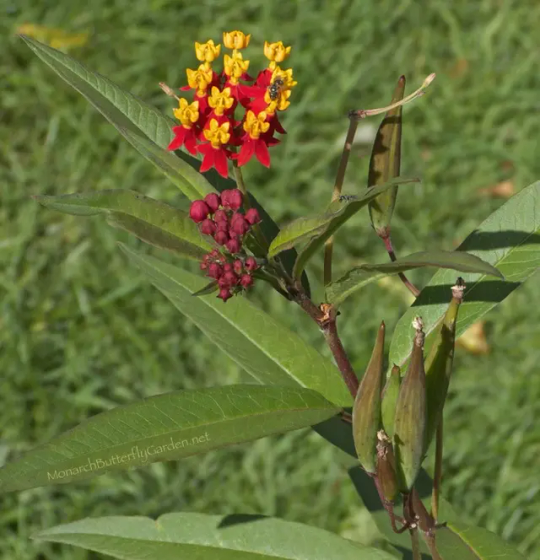
Step Two: Cut back seed pods! You would not believe how many seed pods milkweed makes. You see those little green footballs? You wanna snip these back ASAP. Even if they're tiny, but especially if they're bit. In peak flower production times, I'll go out there at least once a week and just do a look-back and cut them off. You can even yoink them off with your hands if you're in a rush--just don't get that sap into your eyes. If you do this, you're stopping seed production in its tracks--and don't forget, these plants want nothing more than to split those pods open and unleash a hellfire of flying seeds all over the place. They'll float on air, they'll float on water, they'll do whatever until they land on a prime patch of soil and get started.
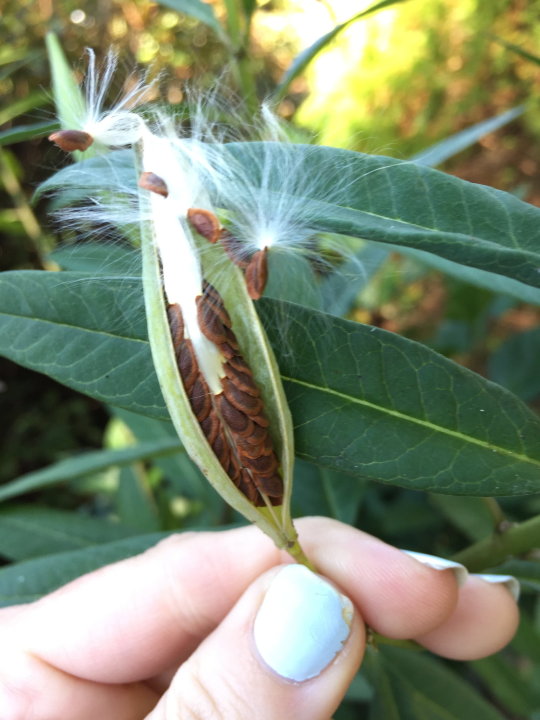
If you see these you're a tinge too late. But also still yoink that off and Dispose of it.
Step 3: Don't give cuttings to your friends. It's tempting. If you're raising caterpillars in a little enclosure and see that every time you refresh your cuttings, the old ones have tons of roots and are ready for a little pot of soil and a name tag? Don't. Resist the best you can. Dispose of your cuttings whenever you go in for a trim.
Step 4: Consider replacing them with something else! I know I already went off about just how hard it was to find native milkweeds for sale, how expensive and difficult they can be to grow--but they're not impossible to grow, and putting in the effort could be worth it! Even as I speak, I'm trying to add as many native milkweeds to my garden as possible--and when I've got something that grows reliably in my backyard, I will eagerly rip up my aging tropical milkweed plants and promptly toss them in the bin so i can put a new, better milkweed in its place. Native milkweeds are more likely to be suited to your environment, making it easier to maintain and more welcoming to the pollinators we gardeners want to help. Not to mention, a lot of them are way pettier than tropical milkweed (in my opinion). Do some hunting online to see what's native to your area--your state's extensions office will likely be great for this! You've likely got great variety--the state of Florida has 21 native milkweeds! Who knows how many your state has! (Not me, I am Floridian, and I am already getting dizzy trying to learn about all 21 of our milkweeds).
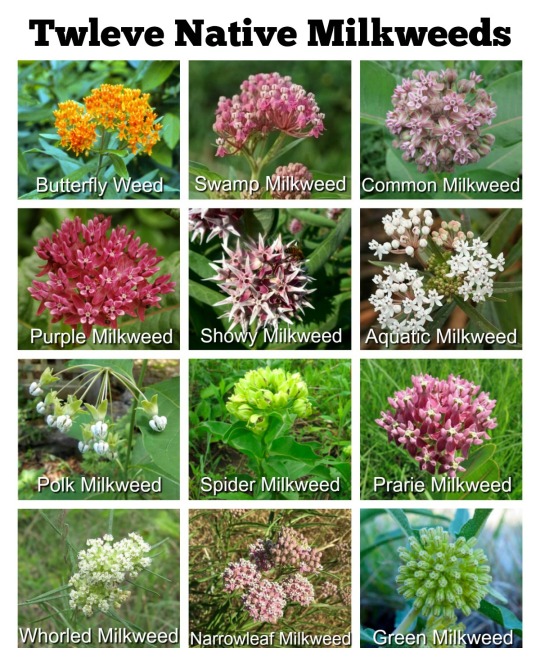
Conclusion!
Anyone who knows me knows I'm not gonna be the one to discourage someone from starting a garden, especially a pollinator gardener, and especially growing milkweed. But avoid tropical milkweed when you can--the harms it can cause far outweigh the quick satisfaction of a busy garden it can bring. Take some time to select a native plant more suited to your area, give it some friends and some time, and soon you'll have an amazing pollinator garden that'll be teeming with life!
#milkweed#tropical milkweed#asclepias curassavica#asclepias#outdoor gardening#succulents#bloodflower#pollinator garden#pollinator gardening#monarch butterfly#ani rambles#out of queue#what was it three hours ago that I was declaring that I wasn't gonna write up a long research post again?#now here i am at 3:30 am ranting about milkweed with like a dozen sources#granted this is nowhere NEAR as long as the biodiversity saga was BUT STILL#i told myself i was gonna write today... i meant one of my novels NOT RANTING ABOUT MILKWEED#if this post blows up this is gonna go on my wall of 'posts that i thought of on the toilet that got way more popular than I expected'#there's not a lot of posts on that wall maybe 2 or 3 but its weird that its happened that many times already
249 notes
·
View notes
Text

Today's Daily Degurechaff is… Huevember 2023 - Day 12
#huevember#dailydegurechaff#youjo senki#the saga of tanya the evil#tanya von degurechaff#i had a hard time coming up with ideas#catch me googling “things that are purple”#shoutout to the results: eggplants. “purple butterflies” (they couldnt name a single species?). and lastly Twilight Sparkle#i didnt end up using any of those ideas bc i didnt think they fit ys vibes#my first thought was bruises honestly#decided not to use that either
80 notes
·
View notes
Text
Thank you, my Beautiful Butterflies!
Operation Beautiful Butterfly 2: Electric Boogaloo was a resounding success!! Thank you so much to @evalka for making the video for me!
#outer wilds#outer wilds spoilers#echoes of the eye spoilers#echoes of the eye#outer wilds prisoner#saga of the butterflies
18 notes
·
View notes
Text
Oh right for anyone not around last summer: I have a little hobby where i raise monarch butterflies from eggs to adults, since I have a milkweed patch and the wild monarch survival rate is 5%. Gonna start chronicling this and will be tagging it "oruguitas saga" if you need to filter for bugs/insects. Anyway.
This year I've upgraded to a larger enclosure which will let me use milkweed cuttings instead of just snagging leaves and hoping for the best!

The bottom-center leaf has an egg on the underside, I took the whole top of the plant as a cutting because it was pretty new growth as opposed to the left and right cuttings, which are more mature. And if you look at the top of the left cutting...
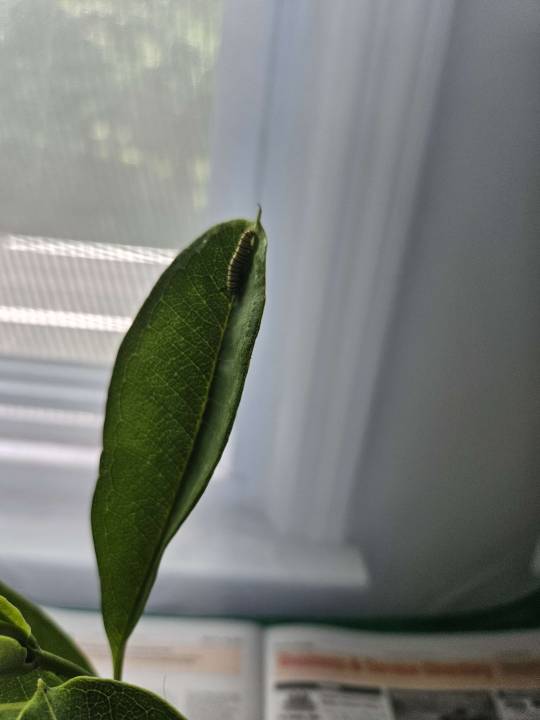
You see this overachiever, the first egg I collected this season who is now well on their way to fulfilling their full butterfly potential. "But Seda!" you ask "Surely you have more babies on the way!"
I do, I certainly do. Behold the eggs due to hatch...probably tonight. Including a set of twins (ok either one monarch decided this spot was great and laid two eggs or another came along and copied the first). A penny for scale, and to show how rich they are:
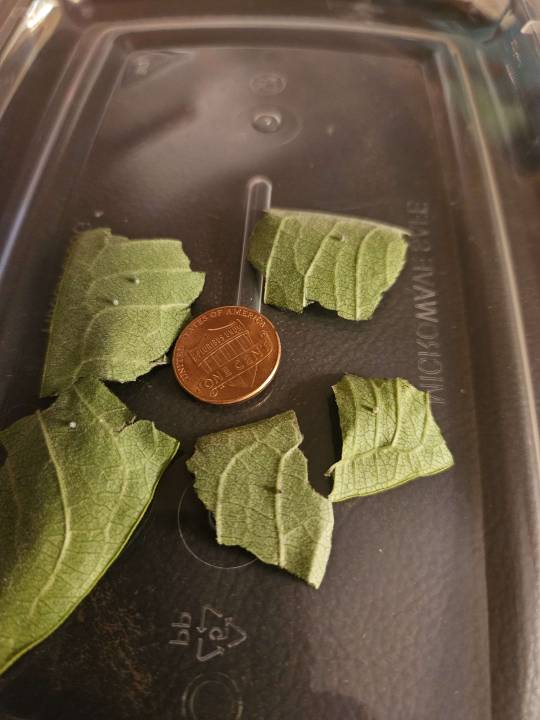
They're living in a takeout food container for the moment but will be transferred to Right Cutting as soon as they're, you know, larva.
43 notes
·
View notes
Text
after seeing enough gifs of the zombie idol group it on my dash I decided to find out if context helped at all

it um . . . context helps a little, I guess?? maybe???
#a butterfly obsesses#sunglasses dude really is just that unhinged#he's managing a group of zombie idols and manages to be the weirdest one there#even more than the girl who just groans and chews on everything#I feel like they left sunglasses dude's VA unsupervised#that's . . . that's dried squid in sunglasses' pocket#for the zombie dog#oh it's Zombie Land Saga btw
21 notes
·
View notes
Text
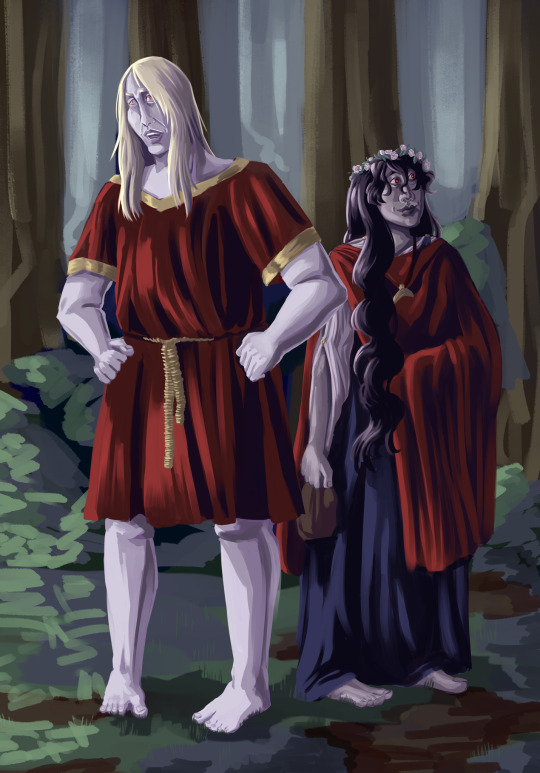
This started out as me wanting to draw my version of Caius' hair (because I imagined it differently from the last illustration I posted) and then turned into this.
This was just going to be Caius yelling at an idiot (a guard? Aro?) and then I drew Myrtis from my fic because she's my babygirl (also new pfp for me!). Anyway, don't ask her for help when Caius is yelling at you, she'll ignore you (unless she cares about you and she thinks the issue is worth her time).
Ultimately, despite my intentions, this just gives 'excuse me, she asked for no pickles.'
#caius is also my babygirl#myrtis is also caius and athenodora's babygirl so this checks out#i have a headcanon that in the early days before industrialization and great wealth the volturi didn't wear shoes except around humans#it would be too easy to wear them out running around the countryside and a pain to replace#myrtis has the most unnerving 'oooh a butterfly stare'#death prophetess should have a thousand yard stare or the saddest eyes... i love them too bad she doesn't have them after ch 21#also crown of myrtles!!! for myrtis!!!#they both have a strong pallor of death (grey) I didn't even try to make it human passing.#abyssal arts#abyssal stuff#the twilight saga#oc: myrtis#fic: cracks in the crypt#twilight fanart#twilight renaissance#fanart#twilight#caius volturi#the volturi#volturi#illustration#art#abyssalwrites#drawing#digital art#artist on tumblr#twilight saga
12 notes
·
View notes
Note
As I see you played a lot of otome games. More than anybody. Can you say your 10 top otome heroines?
I don't think I've played that many otome games x) Don't forget that all my Heroines Otome Games posts aren't necessarily games I've played lol (that would be a lot of games indeed XD)
I've already made a top otome heroine you can see here: https://cleaetpauline60.tumblr.com/tagged/my%20top%20otome%20heroine
But here's my current top 10:
#1 Lulu [ Wand of Fortune ]

#2 Nanami Haruka [ Uta no☆Prince-sama♪ ]

#3 Shiranui Nanami [ NORN9 ]

#4 Chihiro [ Tokyo Yamanote Boys ]

#5 Komori Yui [ Diabolik Lovers ]

#6 Fiona Galland [ Black Wolves Saga ]

#7 Hoshino Ichika [ Collar x Malice ]

#8 Yukimura Chizuru [ Hakuoki ]

#9 Koharu [ NORN9 ]

#10 Beniyuri/Minato Ai [ Kokuchou no Psychedelica ]

I think my top 3 will never change :') But we'll see about the rest because I'm playing Haitaka and I love Jed!! 🥰 And I'm also playing Clock Zero and Nadeshiko is amazing ( ≧ᗜ≦)
Thank you so much for this question, I love being asked this kind of question, especially when it's about otome games. ( ͡° ͜ʖ ͡°)
#ask#psychedelica of the black butterfly#Kokuchou no Psychedelica#norn9#otome#otome game#black wolves saga#hakuouki#collar x malice#wand of fortune#diabolik lovers#Tokyo Yamanote Boys#uta no prince sama#otome heroine
7 notes
·
View notes
Text

#another image from the butterfly saga#death stranding#my photomode#it’s a monarch butterfly btw they’re very lovely and they game has a crazy high res model for them
36 notes
·
View notes
Text
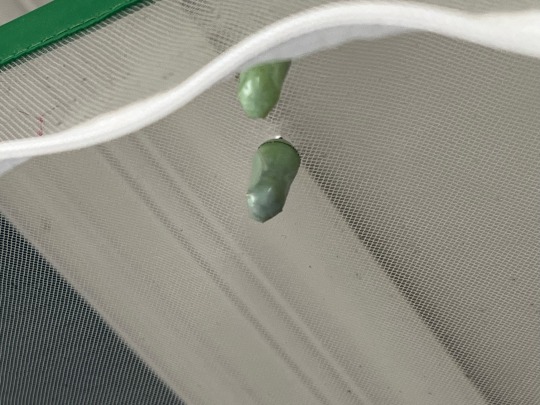
When was the last time I updated about this?? Anyway FIRST BUTTERFLY SHOULD EMERGE THIS WEEKEND
2 notes
·
View notes
Text
Grey Reflections: Episode 24—As the World Turns
If you would like to “Buy Me a Glass of Wine,” you can click this link or the ***DONATE*** link at the bottom of the menu on the left.
I know that I’m wearing this out, but my outside emailer could take quite a while to fix—it could be a day; it could be a month; I don’t know. So, please make sure that you’re subscribed directly to this blog to continue getting updates. Instructions to subscribe…
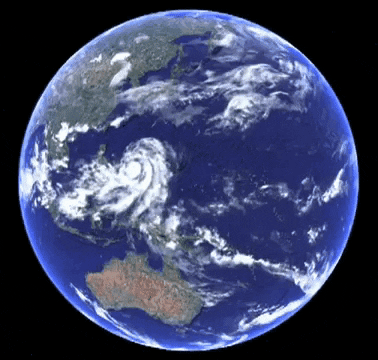
View On WordPress
#Ana Grey#Ana Steele#Anastasia Grey#Anastasia Rose Steele#Anastasia Steele#Becoming Dr. Grey#BG Holmes#Bronze Goddess#Butterfly#butterfly saga#Carrick Grey#Charles Davenport#Christian Grey#Chuck Davenport#Dr. Grey#Dr. Steele#Fiction#Gail Taylor#Gerald Crab#Grace Grey#Grey Continued#Grey Reflections#Herman Grey#Jason#Jason Taylor#love and handcuffs#Luma Grey#Lynn#Marilyn Caldwell#Mending Dr. Steele
0 notes
Text

HAPPY HALLOWEEN!!! Oc chibi version
#disabled artist#oc art#pastel#artist on twitter#cute girls#sensitive content#pretty art#oc#anime#cute oc#zombieland saga lily#oshi no ko#oshi no ko aqua#oshi no ko ruby#Jason#Barbie#pearl#reanimator#bee#butterfly#moth#ladybug#the amazing digital circus#pomni#tadc pomni#fran bow#little misfortune#re#resident evil#bungo stray dogs ango
7 notes
·
View notes
Text

Barbara Roberts
Nickname: Barbie ✨💕
Favorite Color: Pink and Lilac
Favorite Drink: Hot Chocolate
Favorite Film: Barbie and the Island Princess
Height: 5’5
Named after the famous gaslight, gatekeep and girlboss herself, Barbara “Barbie” Roberts. The once shy and introverted turned, fashion adviser, vet tech, pageant queen, and occasional birthday party princess ✨
PSSSSSSSS: Definitely go and check out @lacunafiction ‘s “The Fernweh Saga” immediately!111!
Facts:
If you think the cast hasn’t been forced to watch the entirety of the BCU (Barbie Cinematic Universe and as of 2023 currently sitting at 42 films 💅), you need to spend more time with Barbie.
Barbie and Mrs. Verner will never get along … at first. Barbie isn’t one to not have the first AND last words in a conversation. (Definitely not my way of saying the office scene with R would turn out any different but…. 👀 Mrs. Verner will know she’s making a mistake even if it means Barbie has to talk over her to get her point across.)
But I also like to think that they would swimming get along once they have a common interest (cough R cough) because Barbie sees Mrs. Verner as a respectable, powerful woman. Hopefully Mrs. Verner can also see that in Barbie.
💕RO’s:
💕B - They are so in tune with each other that they unknowingly copy the other’s movements. Literally the bestest of friends. Would have shared a bed with B because why wouldn’t you want a week long sleepover with your bestie as you explore your childhood town!
💕S - Once they are in a deeper relationship, Barbie and S would braid each other’s hair. Barbie also adopts adding a pink section of hair to match S’ cerulean. Mrs. Dorian would also have so many pictures of S and Barbie napping on the couch.
💕R - R once broke Barbie’s Barbie in a game of keep away in grade school, which made Barbie cry in front of R for the first time. R promptly had Mrs. Verner buy them a new one to give to Barbie. Barbie also had an Ken/Barbie doll that she forced R to play with (“Because you both have blonde hair and live in a cool, dream house!”) and eventually gave them before they left. I like to think that R still has that doll :).
💕J - Their matching necklace is actually two half’s of a butterfly that magnetically connects to make a whole butterfly. If there was an option to hug J though-out the story, you better bet your bottom dollar that Barbie would hug them through-out.
#becca warrick#sofia dorran#reese verner#james corvin#the fernweh saga#did I give her basically my love for pink??#Maybe…#her main squeeze is Sofia because pink and blue dynamics is superior#not drawn is the little symbols representing the RO because I kept messing up on drawing the butterfly necklace and scrapped the idea 😭#I do plan on drawing Sofia and Barbie napping together#after this book I think they all need sleep lol#I will also force Mrs. Verner to mentor Barbie#likewise women need to stick together#pls let me get a bit of approval from her 😭 it’s not Barbie’s fault she loves wear bright clothes#any formal clothes would also be pink
31 notes
·
View notes
Text
Where were you when you found out*?
*were taken for a fool
#I personally was walking across my yard and immediately fell to my knees and started pulling up handfulls of grass and screaming#I then had a little fit and was accosted by yellow butterflies (a reoccurring thing in my Punk mourning saga)#they’ve been a fucking sign since the day he left I tell you#are we back? is this what being back is?#edit: we are not#cm punk
6 notes
·
View notes